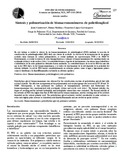Mostrar el registro sencillo del ítem
Síntesis y polimerización de bismacromonómeros de polietilenglicol
| dc.rights.license | http://creativecommons.org/licenses/by-nc-sa/3.0/ve/ | |
| dc.contributor.author | Contreras, Jesús | |
| dc.contributor.author | Medina, Dimas | |
| dc.contributor.author | López Carrasquero, Francisco | |
| dc.date.accessioned | 2015-01-21T15:58:43Z | |
| dc.date.available | 2015-01-21T15:58:43Z | |
| dc.date.issued | 2015-01-21T15:58:43Z | |
| dc.identifier.issn | 1856-3201 | |
| dc.identifier.uri | http://www.saber.ula.ve/handle/123456789/39598 | |
| dc.description.abstract | En este trabajo se realizó la síntesis de un bismacromonómero de polietilenglicol (PEG) mediante la reacción de esterificación de polietilenglicol diol (PEG diol) con cloruro de acriloilo. La eficacia de la incorporación de los grupos acriloilo como extremos de cadena polimerizables, se evaluó mediante las espectroscopias FTIR y de RMN-1H. Posteriormente, se realizó la síntesis de redes homopoliméricas y además el bismacromonómero fue copolimerizado con acrilamida (AAm) y ácido acrílico (AAc). La estabilidad térmica, el grado de hinchamiento y las interacciones hidrofílicas e hidrofóbicas de las redes poliméricas obtenidas fueron analizadas. La estabilidad térmica de la red de PEG fue más alta que la del PEG diol y la del bismacromonómero; y el índice de hinchamiento de la red dependió de la polaridad del solvente utilizado. La red de PEG hinchó considerablemente en solventes polares como el agua y ligeramente polares como el cloroformo y la dimetilformamida y no hinchó en solventes apolares. | es_VE |
| dc.language.iso | es | es_VE |
| dc.rights | info:eu-repo/semantics/openAccess | |
| dc.subject | Bismacromonómeros | es_VE |
| dc.subject | Polietilenglicol | es_VE |
| dc.subject | Redes poliméricas | es_VE |
| dc.title | Síntesis y polimerización de bismacromonómeros de polietilenglicol | es_VE |
| dc.type | info:eu-repo/semantics/article | |
| dc.description.abstract1 | Polyethylene glycol bismacromer was obtained by the esterification reaction of polyethylene glycol diol with acryloyl chloride. The effective incorporation of the polymerizable end acryloyl groups was assessed by FT-IR and 1H-NMR. Subsequently, it was performed the synthesis of homopolymeric networks and furthermore the bismacromonomer was copolymerized with acrylamide (AAm) and acrylic acid (AAc). The thermal stability, the degree of swelling and the network hydrophilic and hydrophobic interactions were evaluated. The thermal stability of the network of PEG was higher than that of PEG diol and the bismacromonomer; and the swelling ratio of the network depended on the solvent polarity used. The polyethylene glycol networks swelled considerably in polar solvents as water and slightly polar solvents as chloroform and dimethylformamide and not swelled in apolar solvents. | es_VE |
| dc.description.colacion | 107-114 | es_VE |
| dc.description.email | jeco@ula.ve | es_VE |
| dc.description.frecuencia | Cuatrimestral | |
| dc.identifier.depositolegal | 200502ME2052 | |
| dc.subject.departamento | Departamento de Química | es_VE |
| dc.subject.facultad | Facultad de Ciencias | es_VE |
| dc.subject.keywords | Bismacromers | es_VE |
| dc.subject.keywords | Poly(ethylene glycol) | es_VE |
| dc.subject.keywords | Polymeric networks | es_VE |
| dc.subject.publicacionelectronica | Revista Avances en Química | |
| dc.subject.seccion | Revista Avances en Química: Artículos científicos | es_VE |
| dc.subject.thematiccategory | Química | es_VE |
| dc.subject.tipo | Revistas | es_VE |
| dc.type.media | Texto | es_VE |
Ficheros en el ítem
Este ítem aparece en la(s) siguiente(s) colección(ones)
-
Avances en Química - Vol 009 - Nº 003
septiembre - diciembre 2014


